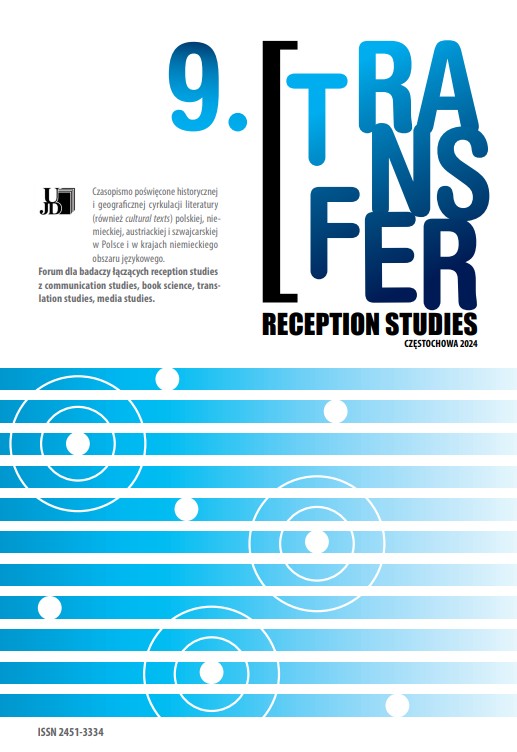Adventuring for Digital Love. On the Readoption of Quest-romance in the Romantic Subplots of Dragon Age: Origins
Abstract
This paper presents a brief examination of the intersections between the literary tradition of quest-romance and digital entertainment. It discusses the readoption of this tradition into the romantic subplots of a fantasy digital role-playing game, Dragon Age: Origins. Grounded in theoretical literary approaches concerning the convention of quest-romance and its historical transformations, especially the introspective turn that can be traced to Romanticism, as well as quest-romance’s cultural influences on popular romance narratives, the exploration addresses four in-game romances available to the player, with specific focus on their relationship to the main heroic plot, and their intrinsic structure based on constant challenges and eventual rewards. The analysis allows one to conclude that the romantic subplots of Dragon Age: Origins not only draw on the literary tradition of quest-romance, but they also engage medium-specific means of expression to accommodate its structural and thematic aspects to the reality of the procedural, ludic medium of the digital game.
Keywords:
digital games, love studies, quest-romance, romance narrativesReferences
References
Aarseth, Espen. “Beyond the Frontier: Quest Games as Post-Narrative Dis-course.” In Narrative Across Media, edited by Marie-Laure Ryan, 361–376. Lincoln: University of Nebraska Press, 2004. Google Scholar
Ashmore, Calvin, and Michael Nitsche. “The Quest in a Generated World.” In Proceedings of the 2007 DiGRA International Conference: Situated Play, vol. 4, 503–509. DiGRA Digital Library, 2007. Google Scholar
Bednorz, Magdalena. Courtly Love in Digital Games: The Rhetoric of Emotion-al Labor in Selected Interactive Narratives. Katowice: Repository of University of Silesia, 2023. Google Scholar
BioWare. Baldur’s Gate II: Shadows of Amn – for Windows. Black Isle Studios, 2009. Google Scholar
BioWare. Dragon Age: Origins – for Windows. Electronic Arts, 2009. Google Scholar
Bloom, Harold. “The Internalization of Quest-Romance.” In Bloom, Harold. The Ringers in the Tower. Studies in Romantic Tradition, 13–35. Chicago-London: University of Chicago Press, 1971. Google Scholar
Frye, Northrop. Anatomy of Criticism: Four Essays. 1957. Princeton: Prince-ton University Press, 1971. Google Scholar
Howard, Jeff. Quests: Design, Theory, and History in Games and Narratives. Wellesley: A K Peters, Ltd., 2008. Google Scholar
Jameson, Fredric. The Political Unconscious. Narrative as a Socially Symbolic Act. 1981. London, New York: Routledge Classics, 2002. Google Scholar
Martin, Catherine Gimelli. “On the Persistence of Quest-Romance in the Romantic Genre: The Strange Case of Pamela.” Poetics Today 12, no. 1 (1991): 87–109. Google Scholar
McDonald, Heidi. “NPC Romance as a Safer Space: BioWare and Healthier Identity Tourism.” Well Played, vol. 1, no. 4 (2012): 23–40. Google Scholar
Moyzhes, Leonid. “Love Without Consequences. Ideology of Romance Representation in Video Games. Case Study of Dragon Age: Inquisition.” In Love and Electronic Affection, edited by Lindsay D. Grace, e-book ed., 157–177. CRC Press, 2020. Google Scholar
Murray, Janet. Hamlet on the Holodeck: The Future of Narrative in Cyberspace. 1997. Free Press, 2016. E-book edition. Google Scholar
Regis, Pamela. A Natural History of the Romance Novel. 2003. Philadelphia: University of Pennsylvania Press, 2007. Google Scholar
Stern, Eddo. “A Touch of Medieval: Narrative, Magic and Computer Technol-ogy in Massively Multiplayer Computer Role-Playing Games.” In Computer Games and Digital Cultures Conference Proceedings, edited by Frans Mäyrä, 257–276. Tampere: Tampere University Press, 2002. Google Scholar
Statistics
Abstract views: 0PDF downloads: 0
License
Copyright (c) 2024 Transfer. Reception Studies

This work is licensed under a Creative Commons Attribution-NonCommercial-NoDerivatives 4.0 International License.
Similar Articles
- Rafał Pokrywka, The Ironical Mode in the Contemporary Romance Novel , Transfer. Reception Studies: Vol. 5 (2020)
- maciejnawrocki, Digital Narrator as a Game Master. The Case of Baldur’s Gate III , Transfer. Reception Studies: Vol. 9 (2024): The Literature (of the) “now.” Interventions, Trends and Revisions
- Jolanta Pacyniak, Narrative structures of threat in "1000 Coils of Fear" ("1000 Serpentinen Angst") by Olivia Wenzel , Transfer. Reception Studies: Vol. 8 (2023): Anxiety and fear in contemporary German-language, Polish and Irish literature
- Adam Regiewicz, Mediaevalism as an Example of Reception Studies , Transfer. Reception Studies: Vol. 9 (2024): The Literature (of the) “now.” Interventions, Trends and Revisions
- Grażyna Barbara SZEWCZYK, Literature - Culture - Dialogue. Problems and dilemas of contemporary literary comparative studies , Transfer. Reception Studies: Vol. 1 (2016): CIRCULATION OF GERMAN-LANGUAGE AND POLISH LITERATURE IN THE XXI CENTURY
- Rafał POKRYWKA, Polish Reception of the German Romance Novel of the 21st Century , Transfer. Reception Studies: Vol. 1 (2016): CIRCULATION OF GERMAN-LANGUAGE AND POLISH LITERATURE IN THE XXI CENTURY
- Ewelina TKACZ, Beyond Genre: Fairy Tales Transformation in the Contemporary German-Language Literature (Exemplified By the Works of and Rafik Schami, Walter Moers, Elfriede Jelinek) , Transfer. Reception Studies: Vol. 3 (2018)
- Szymon Gębuś, New "milestone" in the canon of contemporary comics research [Review of:] Stephan Packard, Andrea Rauscher, Véronique Sina, Jan-Noël Thon, Lukas R.A. Wilde, Janina Wildfeuer. Comicanalyse. Eine Einführung. Stuttgart: J. B. Metzler Verlag, 2019, 228 pp. , Transfer. Reception Studies: Vol. 7 (2022)
- Joanna ŁAWNIKOWSKA-KOPER, The borders of bourgeois class (in)decency. Marcin Kołodziejczyk's Dysforia. Przypadki mieszczan polskich in the context of Polish reception of Gabriele Wohmann , Transfer. Reception Studies: Vol. 3 (2018)
- Gabriela JELITTO-PIECHULIK, Reception of the work of Ricarda Huch in Poland , Transfer. Reception Studies: Vol. 1 (2016): CIRCULATION OF GERMAN-LANGUAGE AND POLISH LITERATURE IN THE XXI CENTURY
You may also start an advanced similarity search for this article.

